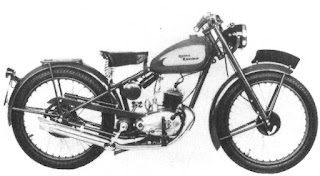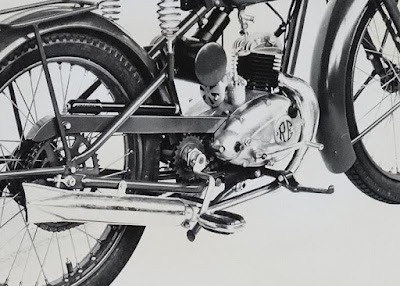 |
| Photo from Royal Enfield Owners Club archives shows a moped. |
Yes, Royal Enfield made a motorcycle equipped with bicycle pedals.
We know this for certain because Royal Enfield Owners Club (UK) archivist Bob Murdoch found a detailed photograph of it. It's a typical 1952 Royal Enfield Model RE2. But it has bicycle pedals.
I first became aware of the pedal-equipped Royal Enfield in Roy Bacon's 1982 book "Royal Enfield, The Postwar Years." There is a small image of it, on page 140 of the book. Its caption says it shows a "Special RE2 with pedals, folding footrests and altered bars for Bermuda."
Straining my eyes I could see those features in the small photo.
 |
| Photo from Bacon's book of the Special RE2 for Bermuda. |
Did a better photo of the special RE2 exist? I wrote the REOC archivist (and new chairman) Bob Murdoch to ask. His reply came back before I could refill my coffee cup.
"The answer is yes, and here it is!" he wrote.
The photo he scanned is labelled "RE/2512 & 2513. 14th January, 1952. Model RE2 with pedals for Bermuda."
The numbers (probably image nunbers) and near identical wording of the captions indicate that this is a companion photo to the side-on view in Bacon's book.
The RE2 was Royal Enfield 125cc two-stroke motorcycle, a much developed civilian outgrowth of the wartime Flying Flea, famously dropped by parachute with airborne troops.
But many photos in Bacon's book are of Royal Enfield factory prototypes. Was the special version with pedals actually manufactured in numbers?
I thought mabe it was, since the background of the image Bob supplied has been so expertly blotted out. It could have been used as an illustration in print advertisements.
 |
| Close-up view of the REOC archive photo. Note that no chain is connected to the pedal sprocket! |
Further evidence came from Graham Scarth, who devotes himself to studying Royal Enfield factory records. His research has solved many mysteries.
"The records show a total of 46 Model RE2s going to Bermuda," he wrote me.
One RE2 went to Holmes, Williams & Purvey in Bermuda on March 6, 1952 (probably just a sample? Maybe even the very motorcycle shown in the REOC archival photo?).
Gibbons in Bermuda received 24 RE2s on Oct. 10, 1952; 20 on Oct. 22, 1953; and one last one on Nov. 2, 1953.
HWP was a BSA motorcycle and Hillman car dealer at the time. Edmund Gibbons Ltd. was a holding company that included Bermuda Motors car dealers.
Unfortunately, "the records do not give any details in the specification column," Graham wrote. In other words, there's no assurance the 46 motorcycles sent to Bermuda had pedals. Based on the January, 1952 date of the archived photo, it seemed possible they did.
Why pedals for Bermuda?
The islands had been free of motor vehicles until they were employed by military bases during World War II. But "in March, 1946, a joint committee of both houses of Parliament submitted a bill allowing each household one car or one 'motor-assisted bicycle'," according to Jonathan Bell in RGmags.com
By 1954 motor vehicles had shoved aside the horses and bicycles of Bermuda. But there were restrictions.
I wrote to Zachary Sagurs of the Bermuda Classic Bike Club. He explained:
"There was a law in place in the late '40s that required all motorcycles to have pedals. This is believed to originate from when autocycles were originally ported into Bermuda.
"That law was changed after a person descending Barkers Hill in Bermuda, took the corner at the bottom of the hill, and his motorcycle having Mobylette pedals welded on (this is assumed, as they normally fitted Mobylette pedals and cranks to meet the law requirements) hit the asphalt, causing a fatality.
"The pedals were left to rotate around with no chain attached. Hence the pedal most likely in the down position as he took the corner."
The Royal Enfield in the archive photo doesn't appear to be wearing pedals just to fool the police. Looking over the photo you see that the kick start lever has been removed but could easily be re-attached. Perhaps it would be carried in the circular tool box, or perhaps you simply started the bike by pedaling. The sprung saddle seat appears to be higher than on contemporary RE2s, perhaps to yield easier pedaling.
Pedals might be handy if you ran out of gas. But "I'd rather push a 125cc motorcycle than try and pedal it, particularly as you'd be stuck with the one drive sprocket ratio, from what I can determine from this photograph," Bob Murdoch commented.
Any chance any of those 46 Model RE2s sent to Bermuda still exist?
"I am one of the largest collectors in Bermuda, and not aware of this model surviving," Zachary wrote.
Too bad. What rarities they would be. Or, maybe not.
Because there is one last bit of evidence that suggests the RE2s sent to Bermuda were just like every other RE2 Royal Enfield manufactured -- without pedals.
Seán Pòl Ó Creachmhaoil, a member of the Bermuda Classic Bike Club since 2012, was kind enough to look up period advertisements from Bermuda Motors. You recall that Bermuda Motors received all but one of the 46 RE2s Graham learned were shipped to Bermuda.
The ads show a typical RE2, with no bicycle pedals attached. It's possible that a stock image was used for the ads rather than a special image for Bermuda showing pedals.
 |
| December, 1952 ad for Royal Enfield in Bermuda. No pedals. |
But there is yet one more factor that makes me doubt the pedal-pusher Royal Enfield RE2 was ever produced in numbers. Bermuda's regulations were in flux in those years.
By 1956, and possibly earlier, the rules changed to allow regular motorcycles up to 150cc. Perfect for the 150cc Triumph Terrier, and Triumph also built a Bermuda-special 150cc version of their normally 200cc Tiger Cub to comply. These are now collector's items in Bermuda.
Perhaps the special pedal version of the RE2 was never produced because the changed law meant that stock 125cc RE2s would do?
BUT WAIT, there's more! Thanks to Allan Hitchcock, of Hitchcocks Motorcycles, we now have a taste of how close Royal Enfield came to producing the pedal-assisted motorcycle. More here.






















http://myroyalenfields.blogspot.com/2011/05/enfield-mofa.html?m=1
ReplyDelete